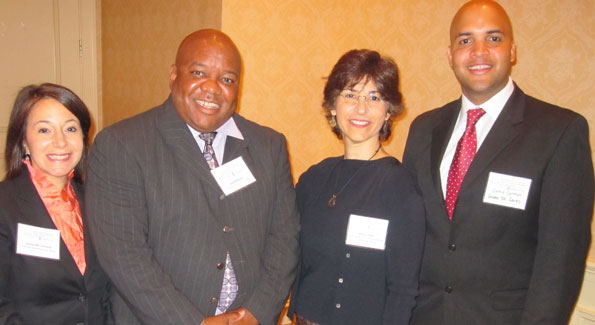Business and nonprofit leaders discuss partnerships and collaboration, and recognize the best of the best
By Jane Hess Collins

Dr. Madye Henson, Trisha Grant and Matthew Mitchell. Grant's ACE Mentor Program won the Greater DC Cares' Community Impact Award for the Nonprofit Sector (photo by Jane Hess Collins)
It was a day of “deepening the discussion,” according to Dr. Madye Henson, President and CEO of Greater DC Cares. Her organization, along with Washington Post Media, co-hosted the event at the Renaissance Washington DC Downtown Hotel on June 15. Henson challenged the over 200 attendees from the business, nonprofit, public and educational sectors to integrate service and volunteerism with philanthropy for greater community impact, and to “move the needle” toward greater cross-sector discussion and cooperation to form alliances and partnerships in an efficient and effective way.
Matthew Mitchell, Chief Information Officer of AARP and chair of the Greater DC Cares’ Board of Directors, opened the summit by introducing the Honorable Michael Brown, an at-large council member from Washington, DC. Brown announced the Good Corporate Citizenship Business Friendly Initiative Act of 2010 that would allow local corporations to “do well and do good” within the district by offering tax incentives for businesses that prove to be exemplary corporate citizens.
Following Councilman Brown’s remarks, Maxine Baker, chair of Leadership Greater Washington, and Mary-Claire Burick, founder of MC Strategy, moderated a strategic leaders’ roundtable comprised of six nominees for the Greater DC Cares’ nonprofit and corporate awards. Roundtable members were Trisha Grant, Executive Director, ACE Mentor Program; Dr. Mark Bergel, Executive Director, A Wider Circle; Maria Tilman, Senior Vice President, CareFirst BlueCross BlueShield; Bill Senhauser, Senior Vice President, Fannie Mae; Brenda Chamberlain, Executive Director, Horton’s Kids; and Albert Morales, Managing Director, IBM.
After each roundtable member shared stories of their high-impact successes and collaborations, the question-and-answer session with the audience revolved around operational efficiency. Are there too many nonprofits? Could nonprofits collectively operate to preclude funders from sponsoring overhead in multiple, like-mission organizations? How do nonprofits handle competition for funding? What is the best strategy to build synergy among nonprofits and with businesses? What resources can business provide in addition to dollars? What criteria do businesses use to evaluate what nonprofits to fund and which ones to turn away?

Sonia McCormick, Joseph Williams, Amy Cohen and Curtis Cannon led a learning session on the impact of cross-sector partnerships (photo by Jane Hess Collins)
Following the roundtable discussion, summit attendees attended one of four learning sessions focused on impact, innovation, partnership and environmental integration.
NBC4 WRC news anchor Jim Handly served as the afternoon master of ceremonies, and introduced Stan Soloway, board member for the Corporation for National and Community Service, and James H. Shelton III, Assistant Deputy Secretary for Innovation and Improvement from the Department of Education. Following their remarks and commentaries on the community impact of Greater DC Cares, Handly introduced keynote speaker Michelle Nunn, CEO of the Points of Light Institute and co-founder of the HandsOn Network. Nunn praised the Washington, DC area for leading the way in the national service movement. Volunteering was up, she said, despite the economic downturn. Nunn shared three trends she has observed in philanthropy across the nation:
First, Nunn saw an increased emphasis on expecting innovation, impact and accountability by nonprofit organizations. The challenge, Nunn said, is to galvanize human capital to meet today’s challenges. The HandsOn Network is leveraging 500,000 volunteer leaders with two million service projects focused on education, economy and environment in the next few years, to demonstrate results as they create positive change.
Next, corporate engagement is becoming more sophisticated among both employees and customers. The Walt Disney Company, for example, offered a free pass to their theme parks to anyone who contributed one entire day of service. Ninety days later, one million people got free entry to a Disney Park. Nunn cited the “extraordinary capacity for corporations to create change” and the tremendous response from citizens to serve when asked.
Finally, the millennial generation is leveraging their use of social media to create interesting, bold change. Groups mobilize solely on Facebook to do good. Extraordinaires can micro-volunteer through phone applications, and even helped find missing people after an earthquake. Nunn praised the millennials for their extraordinary leadership, civic-mindedness, desire to make a difference and love of a challenge.
The nation is at a critical juncture of opportunity and challenge, Nunn said, and the way that the greater Washington, DC service leaders use people to manifest and create innovation, impact and change is watched and modeled across the country.
And finally, it was time for the awards ceremony. The winners are:
Community Impact Award for the Nonprofit Sector: ACE Mentor Program
Essence of Leadership Award for the Nonprofit Sector: Dr. Mark Bergel
Deloitte Spirit of Service Award (and $10,000 grant): Horton’s Kids
Community Impact Award for the Corporate Sector: Fannie Mae
Nonprofit Impact Award: CareFirst BlueCross BlueShield
Jane Hess Collins is a retired Air Force colonel who inspires people to contribute through writing, speaking and (hopefully) example. She also writes the “Get Out and Give Back” newspaper column, conducts workshops for clients to discover their most intrinsic way to serve, and has established game nights for at-risk families throughout the country. You can contact her at www.getoutandgiveback.com.
